 The Seagate Enterprise NAS HDD is a duty-specific drive available in capacities up to 6TB designed to meet the storage needs of small and midrange NAS environments ranging from smaller tower form factors to 16-bay rack units. The wide scope addresses a common need in the enterprise NAS market by blending NAS-specific firmware and features with industry-topping capacity and the performance that a 7K spindle speed offers. Seagate has also done something interesting with the Enterprise NAS drives: they can be paired with optional data recovery service through Seagate, which when paired with the five-year warranty, can provide an additional layer of comfort for SMBs.
The Seagate Enterprise NAS HDD is a duty-specific drive available in capacities up to 6TB designed to meet the storage needs of small and midrange NAS environments ranging from smaller tower form factors to 16-bay rack units. The wide scope addresses a common need in the enterprise NAS market by blending NAS-specific firmware and features with industry-topping capacity and the performance that a 7K spindle speed offers. Seagate has also done something interesting with the Enterprise NAS drives: they can be paired with optional data recovery service through Seagate, which when paired with the five-year warranty, can provide an additional layer of comfort for SMBs.
The Seagate Enterprise NAS HDD is a duty-specific drive available in capacities up to 6TB designed to meet the storage needs of small and midrange NAS environments ranging from smaller tower form factors to 16-bay rack units. The wide scope addresses a common need in the enterprise NAS market by blending NAS-specific firmware and features with industry-topping capacity and the performance that a 7K spindle speed offers. Seagate has also done something interesting with the Enterprise NAS drives: they can be paired with optional data recovery service through Seagate, which when paired with the five-year warranty, can provide an additional layer of comfort for SMBs.
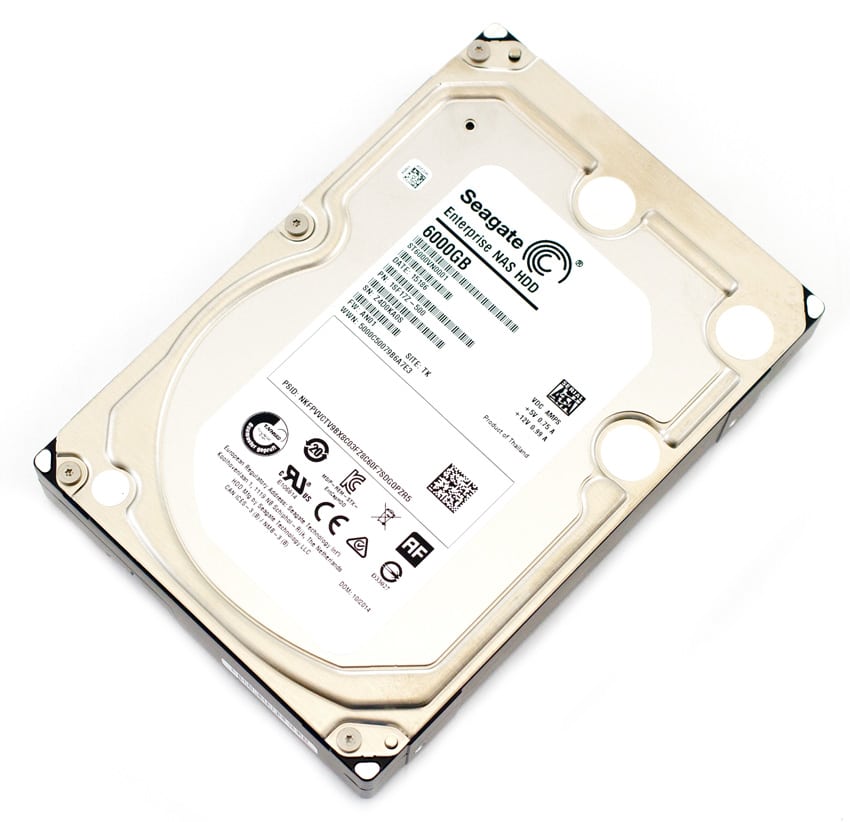
As is the case for most NAS drives, Seagate’s new Enterprise drive is designed to provide sustained performance and 24×7 accessibility. The NAS HDD has a 7200-RPM spindle (to focus on raw, sustained throughput performance), 128MB cache for higher random performance activity, and features advanced power management, allowing it to support multiple power profiles for low power consumption. Seagate has also upped the capacity to an industry leading (alongside the WD Red) 6TB and has included their RAID Rebuild technology, which helps to alleviate the ever time-consuming complete RAID rebuilds.
Seagate has included their +Rescue Data Recovery Service coverage as an optional service for rack-mount or tower NASs populated with their Seagate Enterprise NAS HDDs. With this plan Seagate offers data recovery services due to things like viruses, software issues, and other problems that contribute to data loss. In addition, its mechanical or electrical breakdown feature covers all mechanical drive failures, which begins immediately after the original manufacturer's warranty expires on the drive. Accidental damage is also covered, adding further protection against sudden and accidental damage of files. Seagate believes that this comprehensive in-house offering sets them apart from the rest of the market when it comes to the peace of mind most SMBs are looking for with technology purchases. It’s likely that, while they’re offering it to NAS system vendors and integrators as an additional option to sell, they will probably also offer the bundle with their own branded NAS line, which further emphasizes the infamous “single throat to choke,” if anything goes wrong with the NAS, the drives themselves or data loss occurs.
The Seagate Enterprise NAS HDDs are available in a wide range of capacities: 2TB, 3TB, 4TB, 5TB, 6TB. We will be looking at the 6TB unit and testing it inside a Synology DiskStation DS1815+.
Seagate Enterprise NAS HDD Specifications
- Capacities:
- 6TB (ST6000VN0001)
- 5TB (ST5000VN0001)
- 4TB (ST4000VN0001)
- 3TB (ST3000VN0001)
- 2TB (ST2000VN0001)
- Interface: 6Gb/s
- Humidity Sensor: Yes
- Super Parity
- Low Halogen
- AcuTrac Technology
- Power Balance Technology
- Hot-Plug Support
- Cache, Multisegmented (MB): 128
- Reliability/Data Integrity
- Mean Time Between Failures (MTBF, hours): 1.2M
- Reliability Rating @ Full 24×7 Operation (AFR): 0.63%
- Nonrecoverable Read Errors per Bits Read: 1 sector per 10E15
- Power-On Hours per Year: 8760 (24×7)
- Sector Size (Bytes per Logical Sector): 512/4096
- Limited Warranty (years): 5
- Performance
- Spindle Speed (RPM): 7200
- Interface Access Speed (Gb/s): 6.0, 3.0, 1.5
- Max. Sustained Transfer Rate OD (MB/s): 216
- Average Latency (ms): 4.16
- Interface Ports: Single
- Rotation Vibration @ 1500 Hz (rad/s²): 12.5
- Power Consumption
- Idle Power, Average (W):
- 6.9 (6TB)
- 6.9 (5TB)
- 6.0 (4TB)
- 6.0 (3TB)
- 4.5 (2TB)
- Typical Operating, Random Read (W)
- 11.27 (6TB)
- 11.27 (5TB)
- 9.42 (4TB)
- 9.42 (3TB)
- 8.08 (2TB)
- Power Supply Requirements: +12V and +5V
- Environmental:
- Temperature, Operating (°C): 5 to 60
- Vibration, Nonoperating: 10Hz to 500Hz (Grms): 5.0
- Shock, Operating, 2ms (Read/Write) (Gs): 70/40
- Shock, Nonoperating, 1ms and 2ms (Gs)
- 250 (6TB)
- 300 (5TB)
- 300 (4TB)
- 300 (3TB)
- 300 (2TB)
- Physical
- Height (in/mm, max): 1.028/26.1
- Width (in/mm, max): 4.010/101.85
- Depth (in/mm, max): 5.878/147.0
- Weight (g/lb)
- 1.720/780 (6TB)
- 1.720/780 (5TB)
- 1.400/635 (4TB)
- 1.400/635 (3TB)
- 1.344/605 (2TB)
- Carton Unit Quantity: 20
- Cartons per Pallet: 40
- Cartons per Layer: 8
Design and Build
The Seagate Enterprise NAS HDD sports the usual standard hard drive design of a silver top cover and black metal body. That front of the drive features a product label with the Seagate colors (black, teal, and white) with a very clean and slick looking design. The label simply supplies the product name, company logo, and a QR code that navigates to the product website.
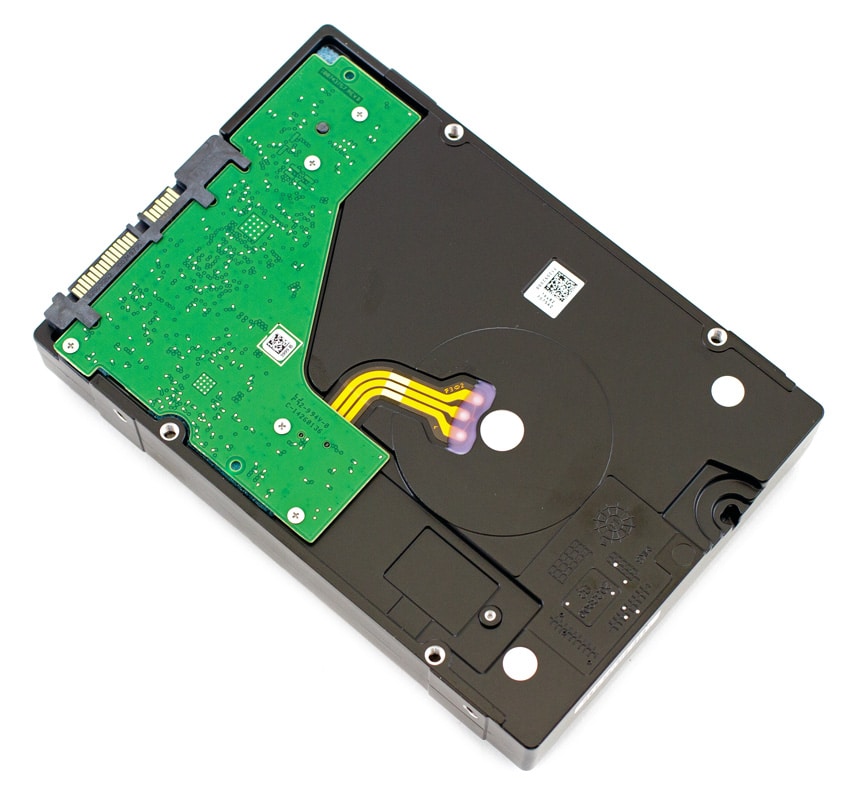
The sides of the Seagate Enterprise NAS HDD feature a total of four screw holes, which allows us to mount the drive. Like we have mentioned in previous reviews, however, some NAS drives feature tool-less installation in the bays for seamless integration. On the rear of the drive, there are power and SATA connectors.
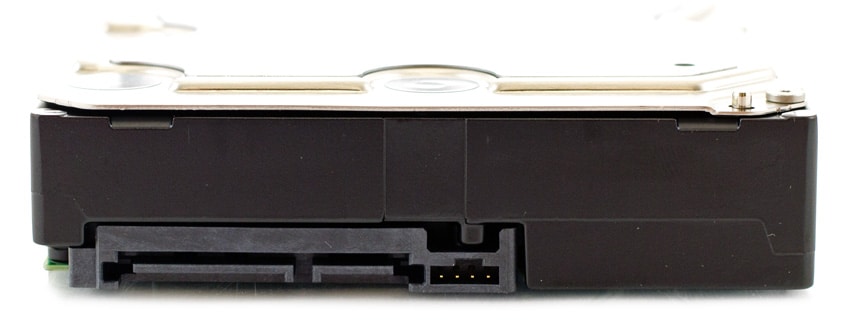
Once the five small screws have been removed, you can open up the drive and remove the circuit board from the body of the Seagate Enterprise NAS HDD. The circuit board is equipped with an LSI controller chip and 128MB of cache from the Nanya DRAM.
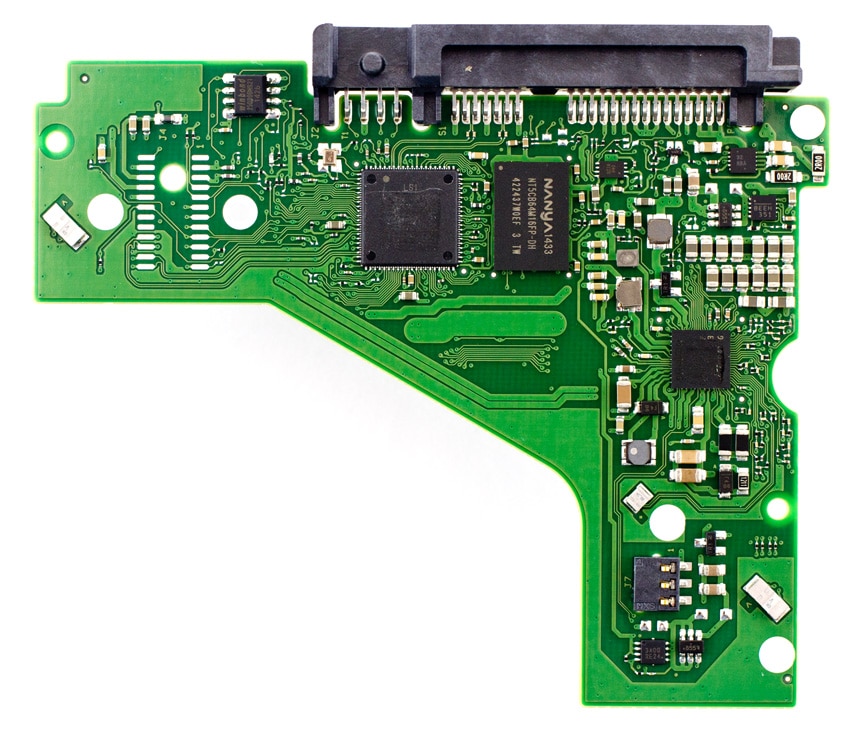
Enterprise Synthetic Workload Analysis
Our enterprise hard drive benchmark process preconditions each drive into steady-state with the same workload the device will be tested with under a heavy load of 16 threads with an outstanding queue of 16 per thread, and then tested in set intervals in multiple thread/queue depth profiles to show performance under light and heavy usage. Since hard drives reach their rated performance level very quickly, we only graph out the main sections of each test.
Preconditioning and Primary Steady-State Tests:
- Throughput (Read+Write IOPS Aggregate)
- Average Latency (Read+Write Latency Averaged Together)
- Max Latency (Peak Read or Write Latency)
- Latency Standard Deviation (Read+Write Standard Deviation Averaged Together)
Our Enterprise Synthetic Workload Analysis includes four profiles based on real-world tasks. These profiles have been developed to make it easier to compare to our past benchmarks as well as widely-published values such as max 4k read and write speed and 8k 70/30, which is commonly used for enterprise drives.
- 4k
- 100% Read or 100% Write
- 100% 4k
- 8k 70/30
- 70% Read, 30% Write
- 100% 8k
- 128k (Sequential)
- 100% Read or 100% Write
- 100% 128k
In the following section of this review, we will show the performance of both iSCSI and CIFS configurations of the Seagate Enterprise NAS 6TB. Seagate supplied StorageReview with eight samples of their new HDDs, which we configured in RAID10 in a Synology DiskStation DS1815+.
We will be including the following drives as comparables in the same DS1815+ configuration:
- WD Red (6TB, 5,400RPM)
- Seagate NAS (4TB, 5,900RPM)
- WD Red Pro (6TB, 5,400RPM)
In our first test measuring 4K random performance (CIFS) with the Seagate Enterprise NAS drive, it showed the best read activity by a significant margin with 614IOPS while having the 2nd strongest write activity at 2,242IOPS. The top performer in the write column was the WD Red Pro.
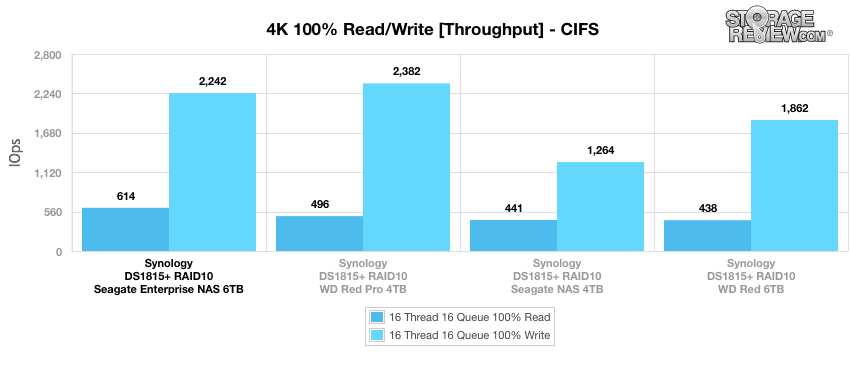
With our iSCSI block-level test, the Seagate Enterprise took top spot in both write and read activity with 1,709IOPS and 3,267IOPS respectively, which were very impressive numbers and greatly improved on the consumer Seagate NAS drive. The next best drive was the WD Red Pro, which boasted 1,523 IOPS write and 3,267IOPS read.
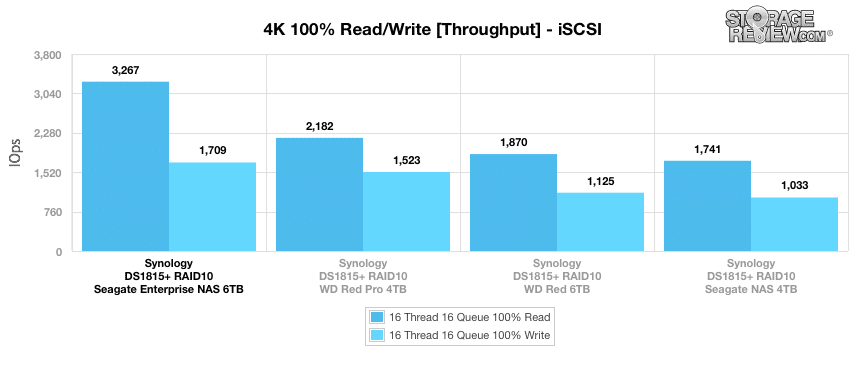
When looking at average latency benchmark (CIFS) 16 Thread 16 Queue 100% read and write, results were very similar to that of the throughput benchmark. The Seagate Enterprise NAS showed the strongest average read latency (416.572ms) while the WD Red Pro once again had the best write latency (107.418ms), though the new Seagate drive wasn’t far behind (114.138ms).
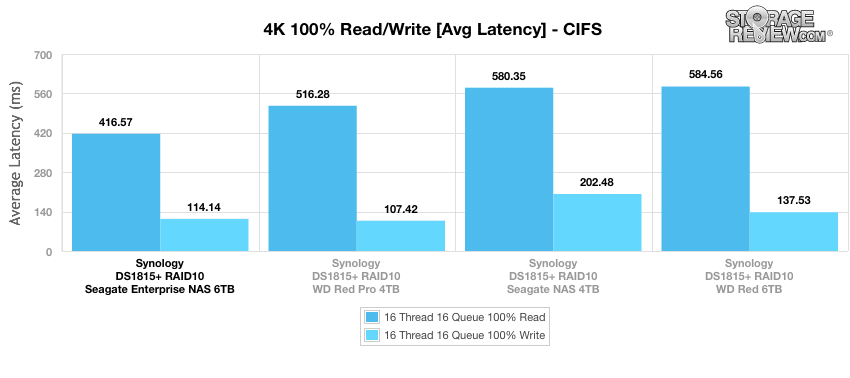
Switching to the iSCSI block-level test, the Seagate Enterprise NAS boasted great latency once again, with only 78.328ms read and 149.808ms write, both of which were noticeably better than that of the WD Red Pro.
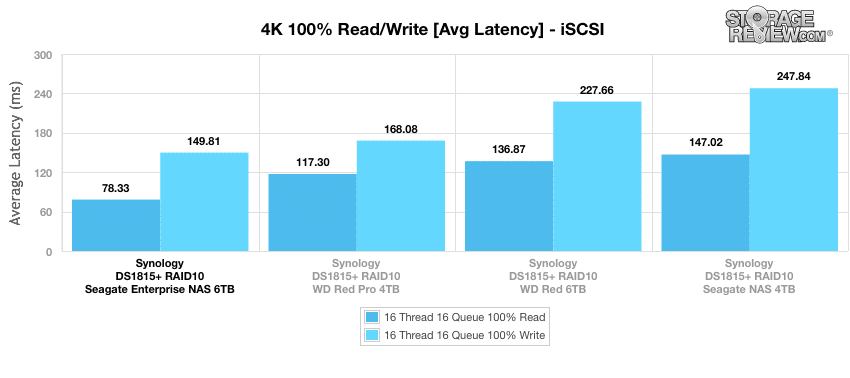
In our max latency tests (CIFS), the Seagate Enterprise posted 2,450ms read (1st) and 1,227.2ms write (2nd), with the top write latency going to the WD Red Pro (914.009ms).
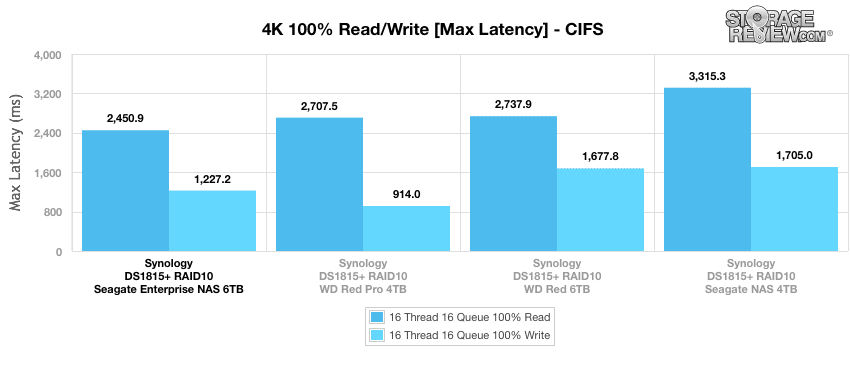
When looking at the same test using iSCSI, the Seagate Enterprise NAS posted a max latency of 1,271.5ms write and 931.454ms read, which was good for 1st and 3rd place on the leaderboard. The top performer in reads was both WD Reds.
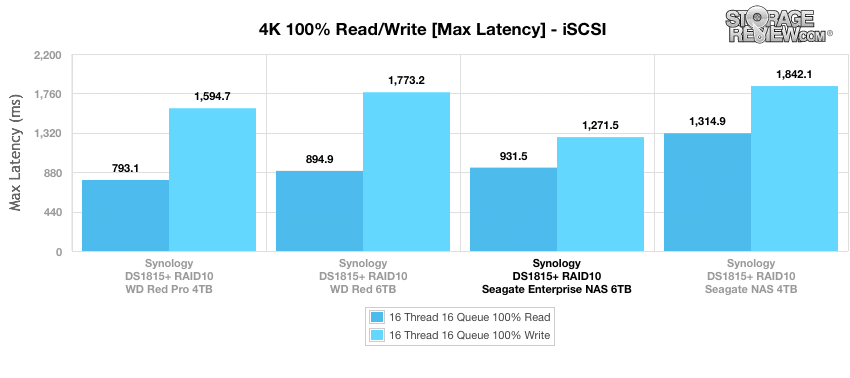
Calculating each of the drive’s standard deviation for the 4k latency show us how consistent the latency results were within each of the categories during our above benchmarks. Here, the Seagate Enterprise NAS continued its trend in great consistency with 140.864ms in write activity and 510.282ms read activity, which was 2nd and 1st respectively. The top write performer was the WD Red Pro.
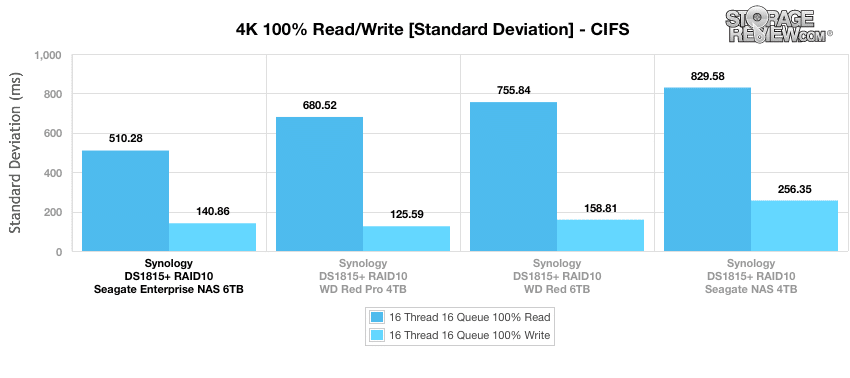
Switching to the iSCSI block-level test, results were mirrored with the Seagate Enterprise NAS taking 1st in reads (56.658ms) and 2nd in writes (200.748ms).
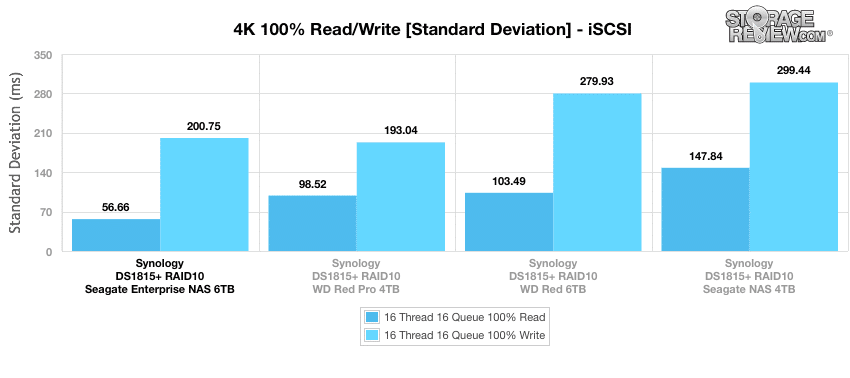
Our next test (CIFS) shifts focus from a pure 4K random read or write scenario to a mixed 8K 70/30 workload where we will show how performance scales in a setting from 2T/2Q up to 16T/16Q. The Seagate Enterprise started out the strongest and was the strongest performer for duration of this benchmark, up until the very end where it tied posted the exact same score as WD Red Pro at 16T/16Q with 708IOPS.
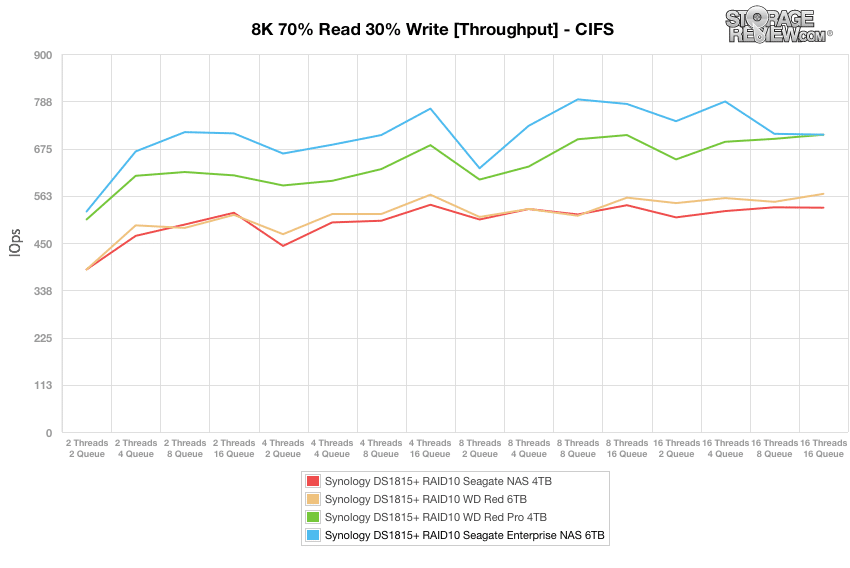
When looking at the iSCSI block-level test, the Seagate Enterprise was the clear winner from the get-go, where it eventually finished at 2,184IOPS (again showing a vast improvement on the other Seagate drive). The WD Red Pro finished 2nd with 1,912IOPS.
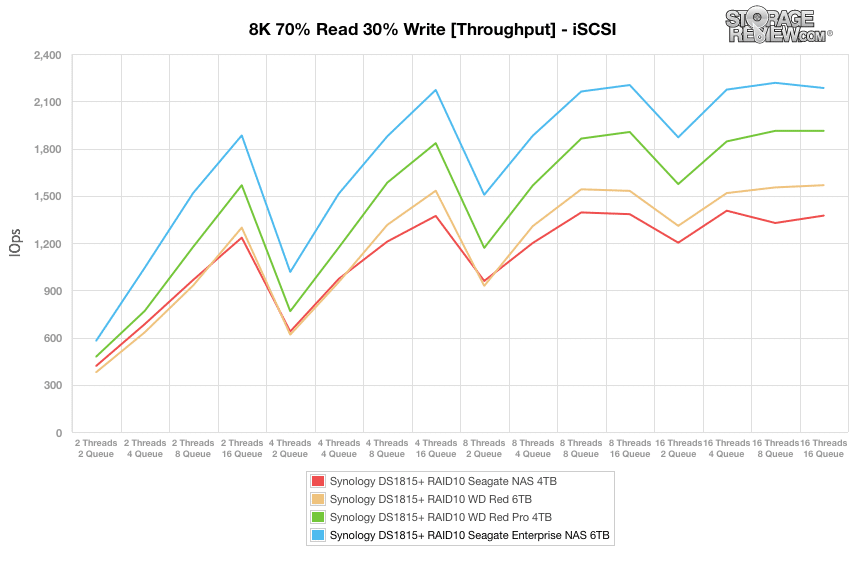
In our average latency test (CIFS) for mixed 8K 70/30 workload, the Seagate Enterprise continued its great performance with 360.63ms by 16T/16Q, though it was narrowly beaten out by the WD Red Pro who had 360.47ms.
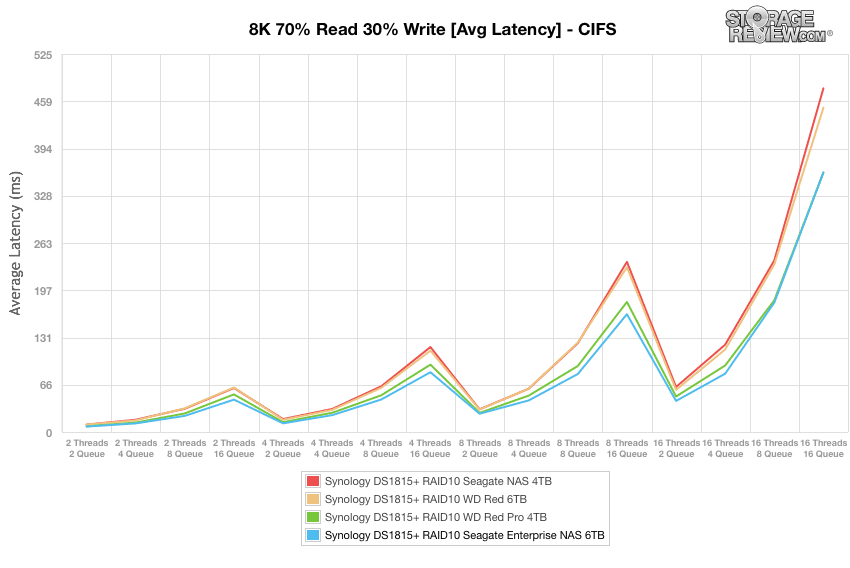
As was the case with the throughput benchmark, when switching to our iSCSI block-level test (average latency), the Seagate Enterprise was the clear winner once again posting an average latency of only 117.15ms by 16Q/16T.
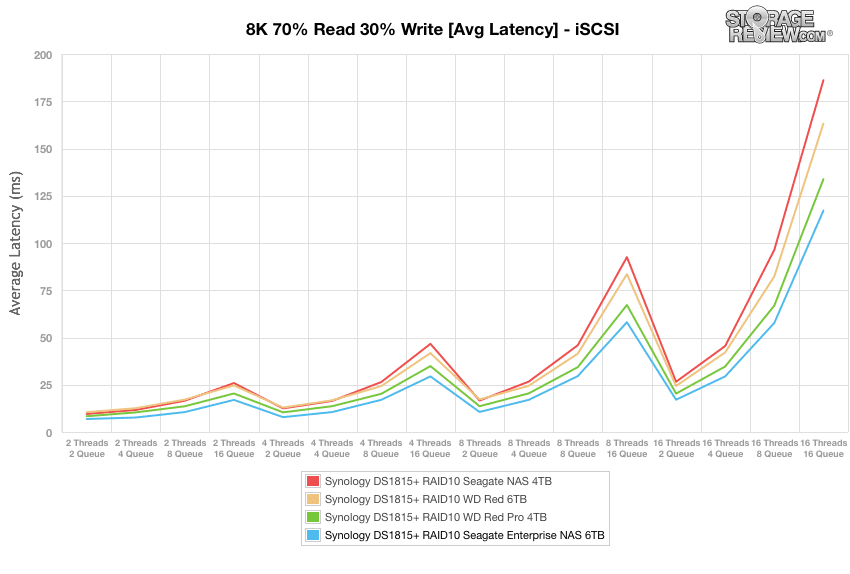
Our max latency test (CIFS) showed the Seagate Enterprise as the most consistent drive throughout the benchmark, though the WD Red (5,427.18ms) drive edged out the Seagate (5888.86) by the end.
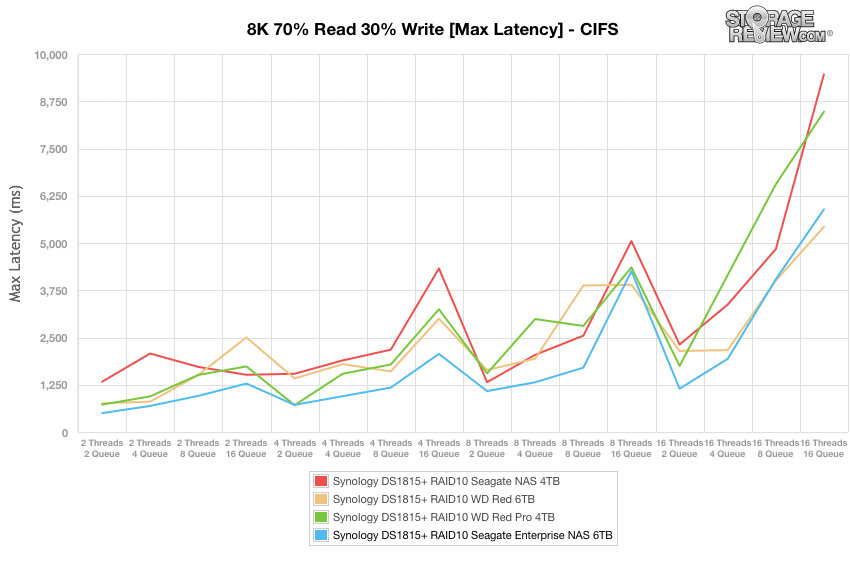
Switching to our iSCSI block-level test, the Seagate Enterprise finished off with a maximum latency of 1,428.75ms, good for 2nd place behind the WD Red Pro (1,243.4ms).
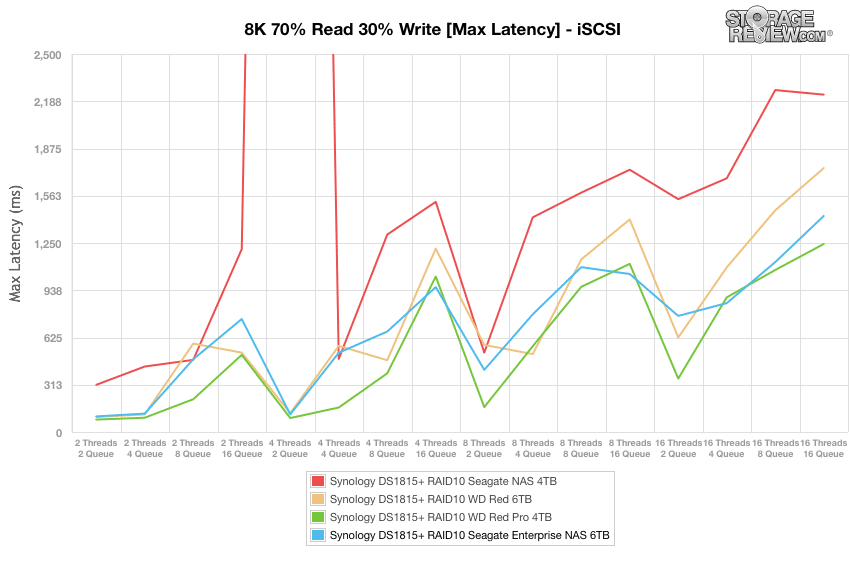
The standard deviation rankings for latency during our 8k 70/30 benchmark CIFS file-level test, show the Seagate Enterprise taking top honors by a large margin with only 372.29ms recorded.
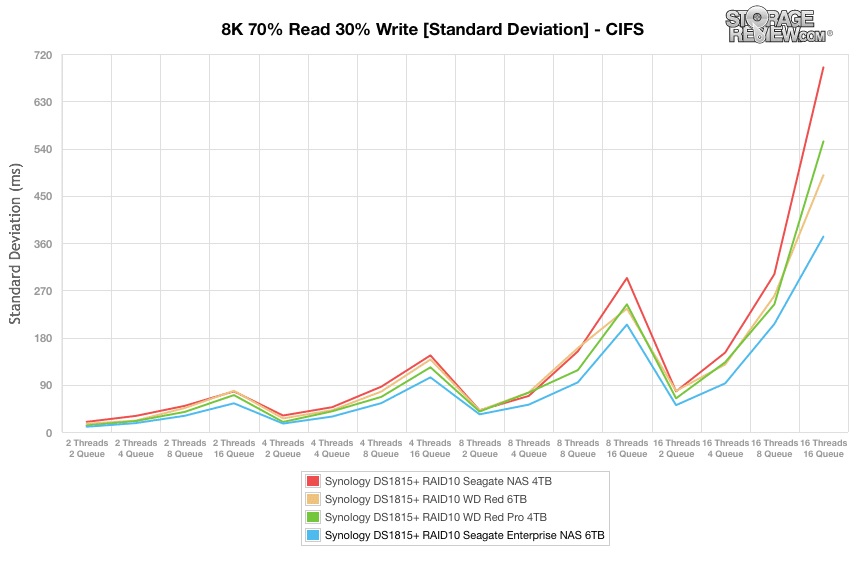
In our iSCSI block-level test of the same benchmark, the Seagate Enterprise NAS ranked first here as well, with 151.6ms by 16 Threads 16 Queue, narrowly defeating the WD Red Pro (155.7ms).
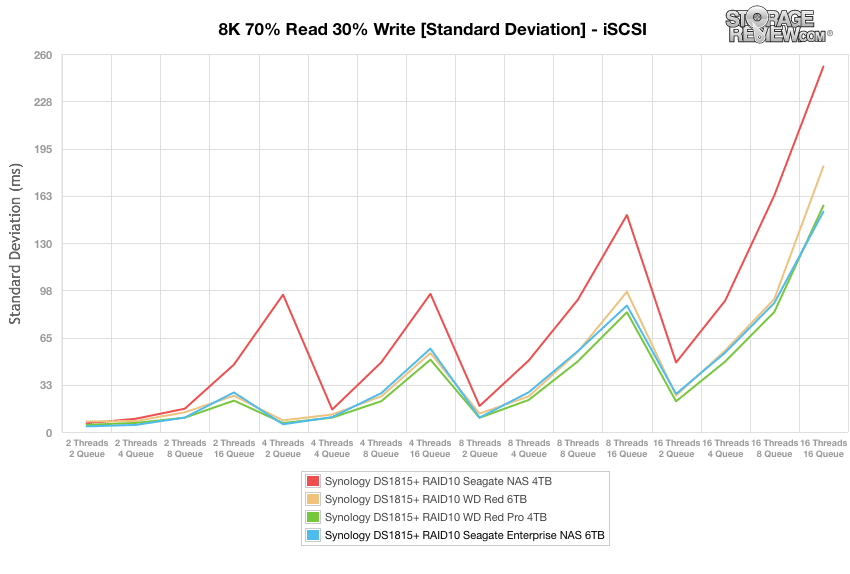
While the first part of the workload comparison focused on random workload performance, our second half measures small and large-block sequential transfer speeds. In our CIFS file-level test of the 8k 100% read/write benchmark, all of the drives performed very similar, though the top read and write performers were the Seagate NAS and WD Red Pro respectively.
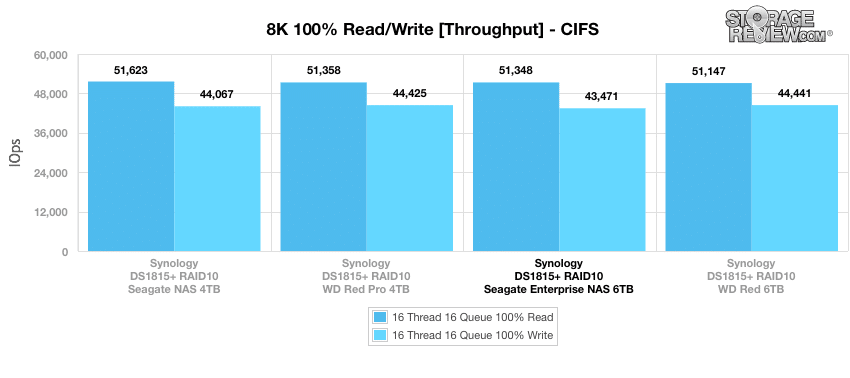
Switching to the iSCSI block-level test, the Seagate Enterprise was back on top ranking at the top of the leaderboard for both read (9,324IOPS) and write (26,056IOPS).
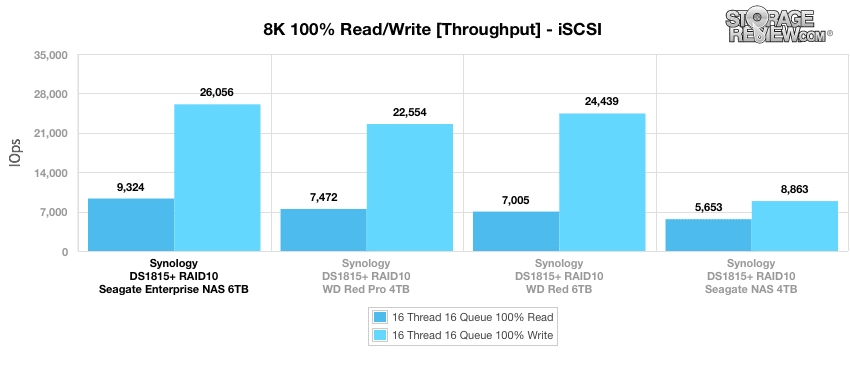
Our last test is the 128k benchmark, which is a large block sequential test that shows the highest sequential transfer speed. Here (CIFS), all of the drives posted very similar results once again. The Seagate Enterprise had 445,765IOPS write and 462,870IOPS read.
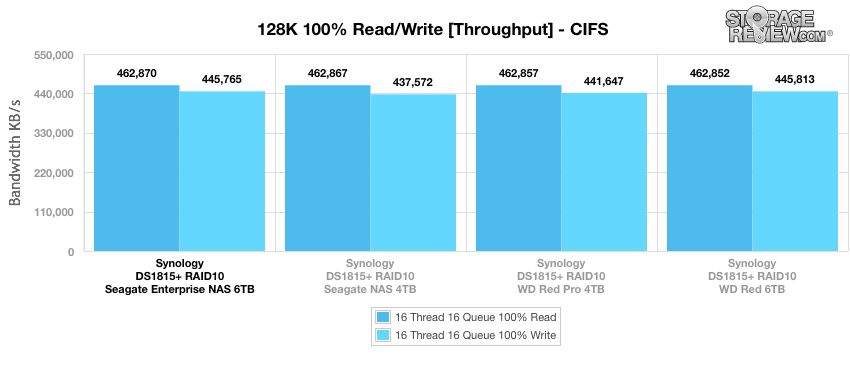
In our iSCSI block-level test, however, the Seagate Enterprise dipped a bit in the write column (316,510IOPS) but was the top performer in read activity at 193,920IOPS.
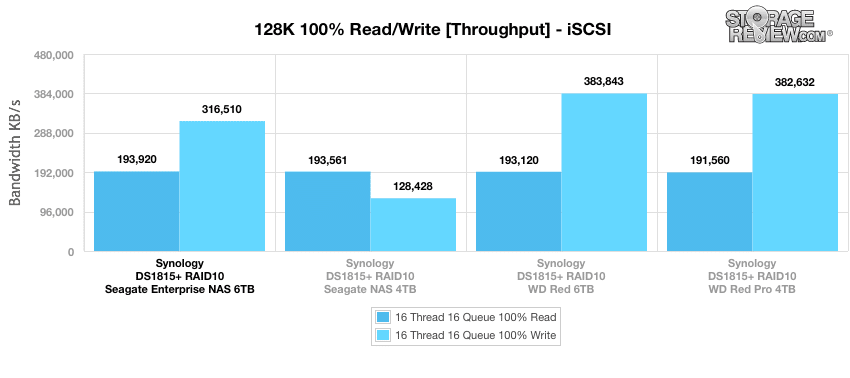
Conclusion
The Seagate Enterprise NAS hard drives are designed to satisfy a variety of NAS environments, from smaller tower form factors to 16-bay rack units, blending NAS-specific firmware and features with a huge capacity point and the benefits of a 7K spindle speed. Seagate has also added optional data insurance by pairing the company's Rescue Data Recovery Service plan (Seagate indicates that most data is recovered either in-lab or remote access within 15 business days or less with almost a 90% success rate) with the an industry-leading five-year warranty on the drive. This certainly will give businesses the much needed peace-of-mind that the data in their server environment is safe and in good hands. In addition to offering the Enterprise NAS HDD in a plethora of capacities (2TB, 3TB, 4TB, 5TB, and 6TB) to satisfy a ton of different use cases and budgets, Seagate has included their unique RAID Rebuild technology, which helps to alleviate the time it takes to complete RAID rebuilds.
As far as its performance goes, the Seagate Enterprise NAS was by in large the best performing of the tested NAS drives. To attain these results, we put the Seagate Enterprise drive (as well as three other top performing NAS drives: Seagate NAS, WD Red, and WD Red Pro) through a gauntlet of our tests, populating an 8-bay Synology DS1815+. The Seagate Enterprise was the top performer in both our CIFS file-level and iSCSI block-level tests, particularly in the read column; the only exception being our max latency (iSCSI) test, in which it finished 3rd. Results of our mixed 8K 70/30 workload benchmarks told a similar story, where the Seagate Enterprise NAS HDD was consistently the top performer (headlined by its performance in iSCSI throughput), though it finished second in our max latency tests. Results were largely mirrored in our large-block sequential transfer tests.
Overall, the 6TB Seagate Enterprise NAS HDD offers a huge leap in performance compared to its predecessor/companion (the regular Seagate NAS HDD) as well as any other drive of its class. Its industry leading 6TB capacity also allows a NAS as small as a 4-bay to top out at a whopping 24TB raw, giving smaller businesses a lot of flexibility when it comes time to grow, without forcing the purchase of a NAS with more bays. Seagate has added a great drive to its duty-specific portfolio of HDDs and thus comes highly recommended.
Pros
- Best-in-class overall performance
- Available in a wide range of capacities including 6TB
- 5-year warranty and Rescue Data Recovery Service plan (optional)
Cons
- Slips behind the Seagate NAS HDD in our CIFS 8k sequential benchmark
Bottom Line
With its focus on reliability, capacity, and great performance, the Seagate Enterprise NAD HDD is the best overall NAS HDD available, especially for multi-tenant NAS environments ranging from SMB to enterprise in scale.
Seagate Enterprise NAS at Amazon
